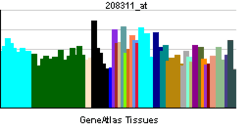GPR50
| GPR50 | |||||||||||||||||
|---|---|---|---|---|---|---|---|---|---|---|---|---|---|---|---|---|---|
| Identifiers | |||||||||||||||||
| Aliases | GPR50, H9, Mel1c, G protein-coupled receptor 50 | ||||||||||||||||
| External IDs | MGI: 1333877 HomoloGene: 3113 GeneCards: GPR50 | ||||||||||||||||
| |||||||||||||||||
| RNA expression pattern | |||||||||||||||||
 | |||||||||||||||||
| More reference expression data | |||||||||||||||||
| Orthologs | |||||||||||||||||
| Species | Human | Mouse | |||||||||||||||
| Entrez | |||||||||||||||||
| Ensembl | |||||||||||||||||
| UniProt | |||||||||||||||||
| RefSeq (mRNA) | |||||||||||||||||
| RefSeq (protein) | |||||||||||||||||
| Location (UCSC) | Chr X: 151.18 – 151.18 Mb | Chr X: 71.66 – 71.67 Mb | |||||||||||||||
| PubMed search | [1] | [2] | |||||||||||||||
| Wikidata | |||||||||||||||||
| View/Edit Human | View/Edit Mouse |
G protein-coupled receptor 50 is a protein which in humans is encoded by the GPR50 gene.[3][4][5]
Function
GPR50 is a member of the G protein-coupled receptor family of integral membrane proteins and is most closely related to the melatonin receptor.[4] GPR50 is able to heterodimerize with both the MT1 and MT2 melatonin receptor subtypes. While GPR50 has no effect on MT2 function, GPR50 prevented MT1 from both binding melatonin and coupling to G proteins.[6] GPR50 is the mammalian ortholog of melatonin receptor Mel1c described in non-mammalian vertebrates. [7]
Clinical significance
Certain polymorphisms of the GPR50 gene in females are associated with increased risk of developing bipolar affective disorder, major depressive disorder, and schizophrenia.[8] Other GPR50 gene polymorphism are associated with higher fasting circulating triglyceride levels and lower circulating High-density lipoprotein levels.[9]
References
- ↑ "Human PubMed Reference:".
- ↑ "Mouse PubMed Reference:".
- ↑ "Entrez Gene: GPR50 G protein-coupled receptor 50".
- 1 2 Reppert SM, Weaver DR, Ebisawa T, Mahle CD, Kolakowski LF (May 1996). "Cloning of a melatonin-related receptor from human pituitary". FEBS Letters. 386 (2–3): 219–24. doi:10.1016/0014-5793(96)00437-1. PMID 8647286.
- ↑ Gubitz AK, Reppert SM (January 1999). "Assignment of the melatonin-related receptor to human chromosome X (GPR50) and mouse chromosome X (Gpr50)". Genomics. 55 (2): 248–51. doi:10.1006/geno.1998.5661. PMID 9933574.
- ↑ Levoye A, Dam J, Ayoub MA, Guillaume JL, Couturier C, Delagrange P, Jockers R (July 2006). "The orphan GPR50 receptor specifically inhibits MT1 melatonin receptor function through heterodimerization". The EMBO Journal. 25 (13): 3012–23. doi:10.1038/sj.emboj.7601193. PMC 1500982
 . PMID 16778767.
. PMID 16778767. - ↑ Dufourny L, Levasseur A, Migaud M, Callebaut I, Pontarotti P, Malpaux B, Monget P (2008). "GPR50 is the mammalian ortholog of Mel1c: Evidence of rapid evolution in mammals". BMC Evolutionary Biology. 8: 105. doi:10.1186/1471-2148-8-105. PMC 2323367
 . PMID 18400093.
. PMID 18400093. - ↑ Thomson PA, Wray NR, Thomson AM, Dunbar DR, Grassie MA, Condie A, Walker MT, Smith DJ, Pulford DJ, Muir W, Blackwood DH, Porteous DJ (May 2005). "Sex-specific association between bipolar affective disorder in women and GPR50, an X-linked orphan G protein-coupled receptor". Molecular Psychiatry. 10 (5): 470–8. doi:10.1038/sj.mp.4001593. PMID 15452587.
- ↑ Bhattacharyya S, Luan J, Challis B, Keogh J, Montague C, Brennand J, Morten J, Lowenbeim S, Jenkins S, Farooqi IS, Wareham NJ, O'Rahilly S (April 2006). "Sequence variants in the melatonin-related receptor gene (GPR50) associate with circulating triglyceride and HDL levels". Journal of lipid research. 47 (4): 761–6. doi:10.1194/jlr.M500338-JLR200. PMID 16436372.
Further reading
- Reppert SM, Weaver DR, Ebisawa T, et al. (1996). "Cloning of a melatonin-related receptor from human pituitary". FEBS Lett. 386 (2–3): 219–24. doi:10.1016/0014-5793(96)00437-1. PMID 8647286.
- Gubitz AK, Reppert SM (1999). "Assignment of the melatonin-related receptor to human chromosome X (GPR50) and mouse chromosome X (Gpr50)". Genomics. 55 (2): 248–51. doi:10.1006/geno.1998.5661. PMID 9933574.
- Strausberg RL, Feingold EA, Grouse LH, et al. (2003). "Generation and initial analysis of more than 15,000 full-length human and mouse cDNA sequences". Proc. Natl. Acad. Sci. U.S.A. 99 (26): 16899–903. doi:10.1073/pnas.242603899. PMC 139241
 . PMID 12477932.
. PMID 12477932. - Slominski A, Pisarchik A, Zbytek B, et al. (2003). "Functional activity of serotoninergic and melatoninergic systems expressed in the skin". J. Cell. Physiol. 196 (1): 144–53. doi:10.1002/jcp.10287. PMID 12767050. replacement character in
|first5=at position 2 (help) - Suzuki Y, Yamashita R, Shirota M, et al. (2004). "Sequence Comparison of Human and Mouse Genes Reveals a Homologous Block Structure in the Promoter Regions". Genome Res. 14 (9): 1711–8. doi:10.1101/gr.2435604. PMC 515316
 . PMID 15342556.
. PMID 15342556. - Thomson PA, Wray NR, Thomson AM, et al. (2005). "Sex-specific association between bipolar affective disorder in women and GPR50, an X-linked orphan G protein-coupled receptor". Mol. Psychiatry. 10 (5): 470–8. doi:10.1038/sj.mp.4001593. PMID 15452587.
- Bhattacharyya S, Luan J, Challis B, et al. (2006). "Sequence variants in the melatonin-related receptor gene (GPR50) associate with circulating triglyceride and HDL levels". J. Lipid Res. 47 (4): 761–6. doi:10.1194/jlr.M500338-JLR200. PMID 16436372.
- Levoye A, Dam J, Ayoub MA, et al. (2006). "The orphan GPR50 receptor specifically inhibits MT1 melatonin receptor function through heterodimerization". EMBO J. 25 (13): 3012–23. doi:10.1038/sj.emboj.7601193. PMC 1500982
 . PMID 16778767.
. PMID 16778767.